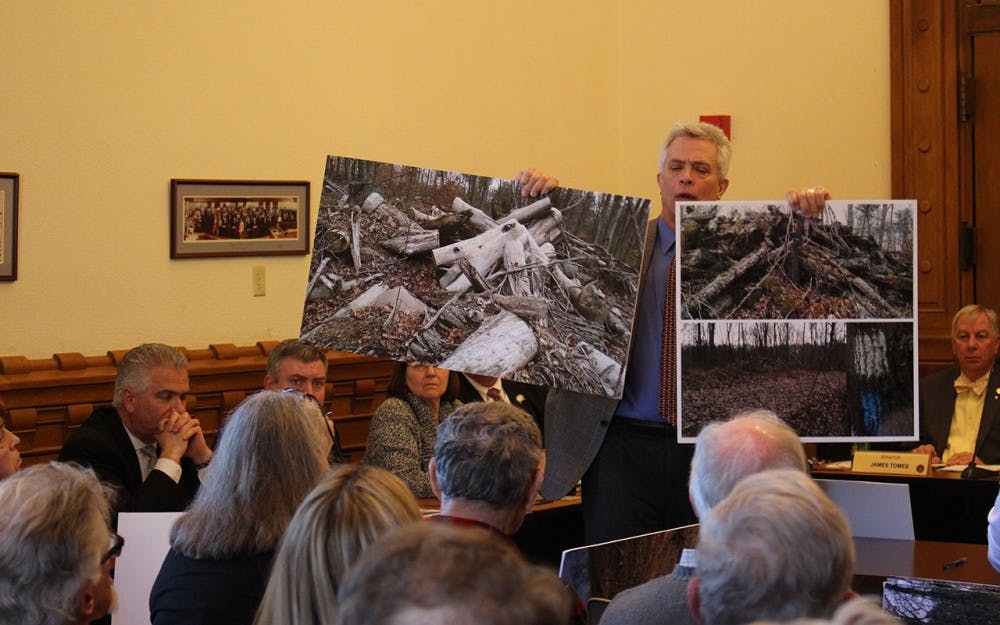At the center of a sweaty and steamy room packed with many more people than it was built for, Chris Marks, an Indiana Forest Alliance member, held up a slice of pound cake.
That slice represents the very small amount — just 10 percent — of state forest land that activists are asking the legislature to protect, she said.
She held up the rest of the pound cake for comparison.
“This is the remainder of the state forest that would still be available for logging,” she said.
After she finished speaking, the room applauded, though they’d been warned by the committee chair not to do so. This crowd wouldn’t easily be tamed.
The small room was packed with upwards of 60 people, and the crowd, which spilled out into the hallway, was at times rowdy. The door to the hearing room was left open to allow flow in and out.
Marks’ testimony was one of the first of a two hourlong Natural Resources Committee hearing on Senate Bill 420, which would designate 10 percent of each state forest as “old forest area,” protected from logging. The bill’s author, Sen. Eric Bassler, R-Washington, made clear this bill would not affect recreation, including fishing, hunting and hiking, in any state land that may be designated old forest areas by the bill.
Committee Chair Sen. Susan Glick, R-LaGrange kept a tight reign on the crowd whenever things seemed to be riling up. She limited testimony to 45 minutes for both the opposition and the support and strictly maintained time limits. The hearing, which was testimony-only, ended shortly after noon, though many stayed after and filled the Statehouse halls. About 30 in support and 20 opposed to the bill didn’t get a chance to testify, and Glick read their names off when time had run out for each side.
The issue is an especially hot one right now because forest activists have complained in recent years about the Indiana Department of Natural Resources’ uptick in logging across state forest lands.
From 2001 to 2015, the money loggers have paid for trees at DNR sales has increased fivefold, and the number of trees sold almost sixfold.
Those in support of DNR management say this increase in logging is merely a return to the numbers of trees that were logged in past decades. They say the forest must be managed in order to be healthy.
Forest preservation activists, on the other hand, claim the forest is best left alone and the uptick is due to a change of forest management under past Indiana Gov. Mitch Daniels. They say he demanded state agencies become self-sufficient, thus forcing the DNR to cut down more trees for funding.
Bassler touched on this idea when speaking about his bill and said if he were in the DNR, he’d probably want to increase logging, too.
“I’m also sympathetic to the position that we as a state have put the DNR in,” Bassler said. “They have an incentive to do what? To cut down trees.”
Activists passed out stickers for the Indiana Forest Alliance, a forest preservation advocacy group. The stickers said “I heart Indiana Forests,” on them with the shape of the heart created by two leaves.
Supporters of the bill covered a wide range of reasons why the legislation is important. Some said old forests are rare in Indiana. Others mentioned that leaving the forest to cycle through life on its own time creates habitat in which certain species thrive. They pleaded with the listening senators, whom they faced during testimony, to allow Indiana forests to grow old and tree trunks to grow wide. Many said while the bill does not protect as much land as they’d want, it’s definitely a positive start.
Todd Stewart, an IFA board member and avid hiker, and Jeff Stant, IFA executive director, delivered an emotional and compelling testimony together. The testimony involved holding up poster-sized pictures of clearcuts from Indiana state forests.
A clearcut is when a logger cuts down all trees in a designated area regardless of age or size rather than picking which ones to fell.
“I want to show there are impacts of the out-of-control logging that goes on today,” Stewart said as Stant held up the pictures to show the senators and the listening audience.
Stant said this bill would merely keep Indiana in compliance with what state auditors already recommend as part of green certification requirements.
“The biggest trees are all down,” he said.
Several of those who testified in support of the bill made sure to emphasize their knowledge in the area — many were experts in ecology or biology, some with doctorate degrees. One area of contention between the two groups who disagree on this issue is in the area of expertise; conservationists, or those who support and believe in DNR forest management, believe activists should not interfere in the realm of foresters, whom they believe to be experts. Activists take offense to this argument and say they are educated and informed, too.
Ray Moistner from the Indiana Hardwood Lumbermen’s Association emphasized his view that foresters and loggers aren’t evil; rather, they are just doing a necessary job.
“The loggers we know are not the villains portrayed by the activists,” Moistner said. “We believe the management of the state forests is a necessity not an option.”
Testimony from Moistner and DNR employees, including Jack Seifert, director of the Indiana DNR Division of Forestry, was marred by scoffing, laughter, and even booing.
In one heated moment, Sen. Frank Mrvan, D-Hammond, asked a DNR employee if loggers, by leaving behind messes and stumps in the state forests, are being responsible stewards of the state.
“The land belongs to the state,” Mrvan said forcefully, and thunderous applause erupted.
Pandemonium ensued for a few brief seconds before Glick was able to re-establish order.
“It’s not owned by the DNR exclusively,” someone shouted from the crowd. “It’s owned by the people.”






